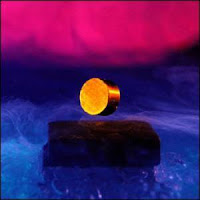 |
| Source: Science Daily |
A new study published in Science examined a particular class of high-Tc superconductor, known as an iron pnictide. ("Pnictide" refers to an atom in the same column as nitrogen in the periodic table.) K. Hashimoto et al. found evidence of a quantum critical point (QCP): a place where the material's properties change radically due to quantum fluctuations rather than changes in temperature or pressure. While many physicists suspect the presence of a QCP in high-Tc superconductors, none have found unambiguous evidence for its existence. The current study is still not definitive, but the particular iron pnictide material the researchers used provides far cleaner data—and stronger hints that the QCP is actually there. Its presence would reveal a great deal about the inner workings of high-Tcsuperconductors, perhaps helping lead to even higher temperature superconducting devices.
In the case of high-Tc superconductors, the key parameters are temperature and doping. The iron pnictide superconductor in the recent study was BaFe2(As1-xPx)2, where "x" is the doping fraction. (In this case, the pnictide is the arsenic.) The researchers picked this particular pnictide due to the ease with which pure crystals of the material can be grown and how clean the resulting data is. For x values roughly between 0.2 and 0.7, BaFe2(As1-xPx)2is a superconductor; outside those values, the material isn't superconducting at any temperature.
A QCP—if it is present—marks another type of phase transition [beyond solid-liquid-gas-plasma], where quantum fluctuations at absolute zero change the superconducting behavior of the material. While absolute zero isn't experimentally achievable, the quantum fluctuations start at (relatively) higher temperatures, changing the behavior of the flow of the charge carriers.
Ars Technica:
Quantum fluctuations may uncover a clue to high-temperature superconductivity
Comments